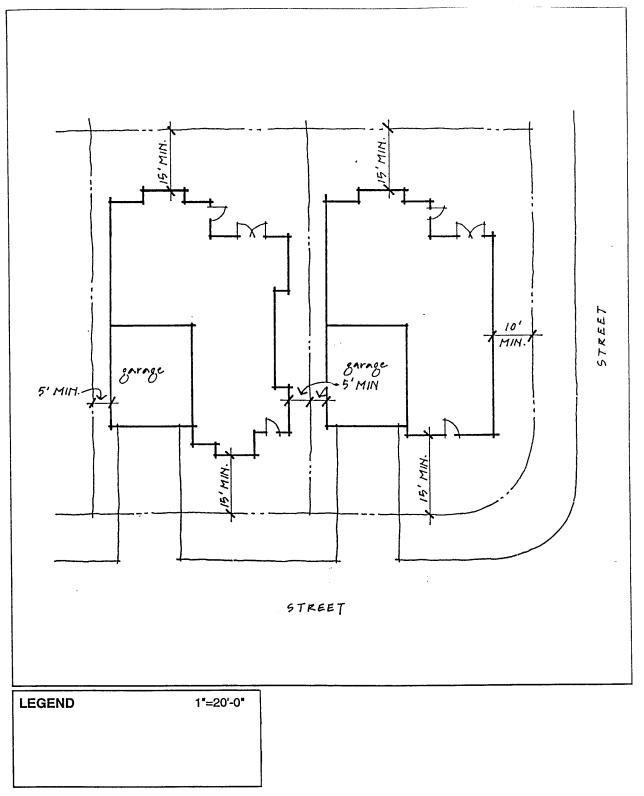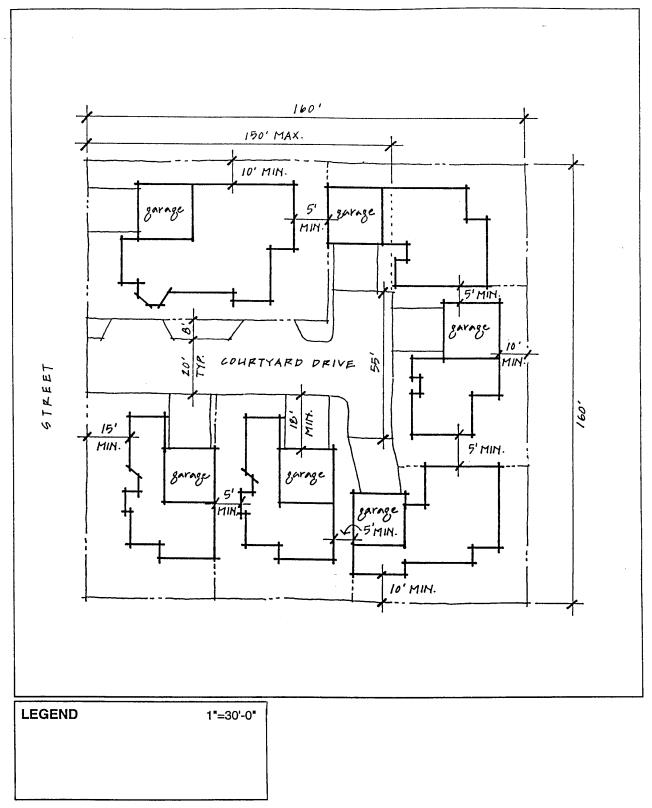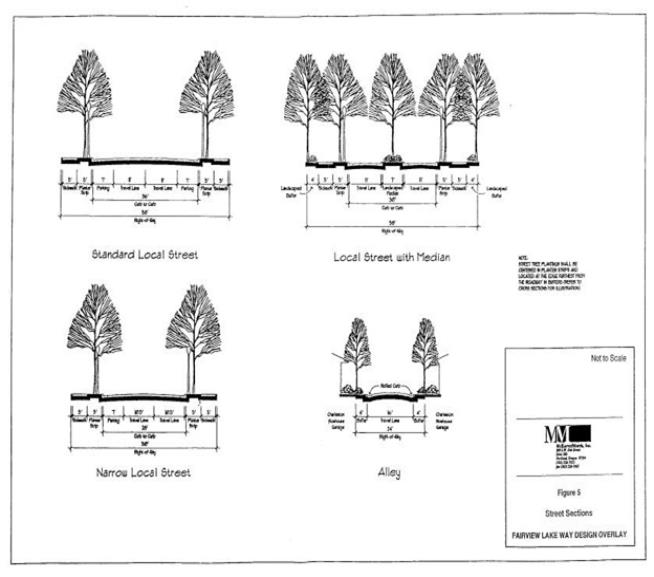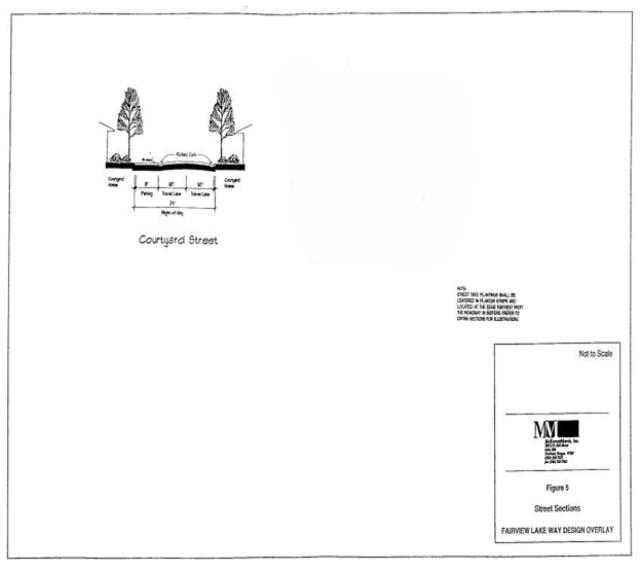Chapter 19.107
SOUTH FAIRVIEW LAKE DESIGN OVERLAY
Sections:
19.107.050 Development standards.
19.107.010 Purpose.
This design overlay zone is intended to offer design flexibility for properties adjacent to the south side of Fairview Lake which provide a variety of housing opportunities for city residents while maintaining the established residential character of the area and protecting important environmental and scenic values of the lake. If, during the administration of this chapter, standards or requirements create uncertainty or ambiguity, the city shall interpret these regulations according to the intent expressed in the record for the adoption and subsequent amendment to the South Fairview Lake design overlay zone. (Ord. 1-2024 § 1 (Att. A); Ord. 11-2014 § 1 (Exh. 1); Ord. 6-2001 § 1)
19.107.020 Applicability.
The South Fairview Lake design overlay zone designation may be requested at the discretion of the applicant at the time of subdivision, partition, or development permit review. (Ord. 11-2014 § 1 (Exh. 1); Ord. 6-2001 § 1)
19.107.030 Permitted uses.
The permitted uses in the R-7.5 zone shall continue to apply in the South Fairview Lake design overlay zone. The permitted land uses are located in FMC 19.30.020. All uses shall comply with the dimensional standards (FMC 19.30.030), design standards (FMC 19.30.040 through 19.30.060), and/or special standards (FMC 19.30.080) applicable to the development.
All housing shall comply with the development standards and design standards of FMC 19.107.050 and 19.107.060. If there is a conflict the dimensional standards and design standards in R-7.5 zone in Chapter 19.30 FMC supersede the requirements in this chapter. In addition to the housing types permitted in the R-7.5 zone, the following residential housing types are also permitted in the South Fairview Lake design overlay:
A. Charleston Row Houses. These are detached residences on relatively narrow lots. Each residence is typically located with a minimum zero-foot side yard setback on only one side of the lot and a minimum six-foot side yard setback on the opposite side of the lot with a total of at least six feet between the structures. The front and side yards serve as the open space on the lot. Garages are at the rear of the building with access to an alley (Figure 19.107.030.A).
B. Courtyard Cluster Homes. These are detached residences developed in groups of five to seven lots. Each residence is typically located with a minimum zero-foot side yard setback on only one side of the lot, and a minimum five-foot side yard setback on the opposite side, with a total of at least five feet between the structures. The lots are clustered around a common driveway, which provides pedestrian and vehicle access to all or the majority of the homes (Figure 19.107.030.B).
Figure 19.107.030 – Fairview Lake Way Design Overlay
Detached Single-Unit Home
Figure 19.107.030.A – Fairview Lake Way Design Overlay
Charleston Row House Home
Figure 19.107.030.B – Fairview Lake Way Design Overlay
Courtyard Cluster Home
(Ord. 1-2024 § 1 (Att. A); Ord. 11-2014 § 1 (Exh. 1); Ord. 6-2001 § 1)
19.107.040 Conditional uses.
All conditional uses in the R-7.5 zone shall continue to be allowed as conditional uses in the South Fairview Lake design overlay zone. (Ord. 11-2014 § 1 (Exh. 1); Ord. 6-2001 § 1)
19.107.050 Development standards.
A. Development Standards. See Table 19.107.050.A – Development Standards.
|
Development Standards |
Single-Unit Detached Dwellings |
Duplexes, Triplexes, Quadplexes, Townhouses, Cottage Clusters |
Charleston Row House (Figure 19.107.030.A) |
Courtyard Cluster Homes (Figure 19.107.030.B) |
|---|---|---|---|---|
|
Density |
||||
|
Minimum lot size |
5,000 square feet |
* (1) |
3,000 square feet |
3,000 square feet |
|
Maximum lot size |
|
* (1) |
4,500 square feet |
6,500 square feet |
|
Minimum average lot area per unit |
6,000 square feet |
* (1) |
3,000 square feet |
4,000 square feet |
|
Lot Dimensions |
||||
|
Minimum average lot width |
50 feet |
* (1) |
30 feet |
50 feet |
|
Maximum average lot depth |
80 feet |
* (1) |
90 feet |
80 feet |
|
Lot Coverage |
||||
|
Maximum lot coverage for all structures |
60% |
* (1) |
50% |
2-story structures: 50% 1-story structures: 60% |
|
Height |
||||
|
Maximum building height |
35 feet |
* (1) |
35 feet |
35 feet |
|
Setbacks |
||||
|
Front – minimum |
15 feet |
* (1) |
10 feet |
10 feet |
|
Front – maximum |
20 feet |
* (1) |
15 feet |
15 feet |
|
Side – minimum |
5 feet |
* (1) |
Interior – 6 feet one side only/0 feet one side only. Corner lot – 10 feet on street side, minimum building separation – 6 feet. Builders will provide a site plan that indicates setbacks on adjoining lots at the time of application. |
Interior – 5 feet on one or both sides/0 feet one side only is optional. Corner and between clusters – 10 feet on street side, minimum building separation – 5 feet. |
|
Rear – minimum |
15 feet/adjacent to Fairview Lake conservation easement |
* (1) |
8 feet from alley |
10 feet |
|
Garage entrance – minimum |
18 feet |
* (1) |
Alley – 8 feet |
Street and common driveway – 18 feet |
|
Parking (off-street) |
per FMC 19.164.030 |
per FMC 19.164.030 |
per FMC 19.164.030 |
per FMC 19.164.030 |
|
*(1) Middle housing types in this column shall comply with the R-7.5 zone dimensional standards (FMC 19.30.030), design standards (FMC 19.30.040 through 19.30.060), and/or special standards (FMC 19.30.080) applicable to the development. |
||||
(Ord. 1-2024 § 1 (Att. A); Ord. 11-2014 § 1 (Exh. 1); Ord. 6-2001 § 1)
19.107.060 Design standards.
The following design standards shall apply to residential developments:
A. Street System. The purpose of the street system standards is to create a safe, aesthetically pleasing, and pedestrian-oriented neighborhood. Four of the five street types are narrower than the typical city standard minimizing the physical presence of paved areas, allowing for additional landscaping adjacent to streets and sidewalks, and effectively controlling traffic speeds. All streets are intended for traffic speeds of 25 miles per hour or less. Street design requirements are summarized in Table 19.107.060 and illustrated in cross-section in Figure 19.107.060.A.
1. Standard Local Street. Standard local streets shall constitute public streets with a 58-foot right-of-way consisting of two 11-foot travel lanes, two seven-foot parking lanes, two five-foot planter strips, and two five-foot sidewalks.
2. Narrow Local Street. Narrow local streets shall constitute public streets with a 50-foot right-of-way consisting of two 10.5-foot travel lanes, one seven-foot parking lane, two five-foot planter strips, and two five-foot sidewalks.
3. Local Street with Median. The local street with a median shall constitute a public street with a 58-foot right-of-way consisting of two 11-foot travel lanes, a seven-foot median, two five-foot planter strips, two five-foot sidewalks, and two four-foot landscaped buffers. No on-street parking will be allowed, to minimize the width of the right-of-way.
4. Alley. Alleys shall constitute public streets with a 24-foot public right-of-way consisting of a 16-foot travel lane and two four-foot buffers. The buffer shall be paved along the front of the garages and the remainder shall be landscaped with ground covers, shrubs, or a combination thereof. Alleys shall have rolled curbs with gutters draining to a storm sewer system.
5. Courtyard Street. Courtyard streets shall constitute private streets with a 28-foot right-of-way consisting of two 10-foot travel lanes, one eight-foot parking lane, and a maximum length of 150 feet. Landscape which extends from the edge of the paved surface to the house facade shall be planted with trees, ground covers and shrubs, or a combination thereof, and shall be maintained by a homeowners association.
|
Street Types |
Right-of-Way |
Travel Lane |
Parking |
Planter Strip |
Median |
Sidewalk |
Additional Landscaped Buffer |
|---|---|---|---|---|---|---|---|
|
Standard local street |
58′ |
11′/11′ |
7′/7′ |
5′/5′ |
no |
5′/5′ |
no |
|
Narrow local street |
50′ |
10.5′/10.5′ |
7′ one side |
5′/5′ |
no |
5′/5′ |
no |
|
Local street with median |
58′ |
11′/11′ |
no |
5′/5′ |
6′ |
5′/5′ |
4′/4′ |
|
Alley |
private tract 24′ |
8′/8′ |
no |
no |
no |
no |
4′/4′ |
|
Courtyard street (private) |
private tract 28′ |
10′/10′ |
8′ one side |
N/A |
N/A |
N/A |
N/A |
Figure 19.107.060.A – Fairview Lake Design Overlay
Street Sections
Figure 19.107.060.A – Fairview Lake Design Overlay
Street Sections (continued)
B. Fences. The maximum height for front yard and street side yard fences shall be four feet.
C. Intersections.
1. Vision Clearance Areas. Signage, structures and plant material 42 inches above grade shall be prohibited within the vision clearance area located at the intersection of streets and/or alleys. The area is defined by a triangle with two sides of the triangle extending 15 feet from the intersection.
2. Curb Extensions. Curb extensions shall be provided as required by the adopted Fairview Lake Way standards.
3. Paved Surface Details. Paving and curb cuts shall facilitate safe pedestrian crossing and meet all ADA requirements for accessibility. Textured accent paving shall be used at the main entry intersection to clearly define the pedestrian crosswalk. The pavers or pattern shall be of a level material which does not impede wheelchair accessibility or conflict with surfacing for sight-impaired individuals.
D. Landscape.
1. Landscape Plans and Installation.
a. Prior to issuance of building permits, the developer shall submit landscape plans and completion scheduled for all areas within the public right-of-way or common open spaces.
b. Landscape materials shown on the approved plans for public right-of-way or common open space areas shall be installed prior to issuance of occupancy permits for more than 80 percent of the homes abutting these public areas.
2. Planter Strips.
a. All planter strips shall be a minimum of five feet wide and shall be planted with either lawn, ground cover or a combination of shrubs and ground cover such that the entire surface area is covered with plant material. Placement of plant material shall adhere to clear sight line requirements as provided in FMC 19.140.030(D), Vision Clearance Areas.
b. Planter strips without adjacent parking shall have street trees in conjunction with low ground covers and/or shrubs to enhance visibility while still providing a psychological and physical barrier from passing traffic. Plantings shall be predominantly evergreen year-round, provide seasonal interest with fall color or blooms, and at maturity grow within the confines of the planter strip. Planter strips with adjacent parking shall have only street trees and lawn or low ground cover which adheres to the requirements of this section.
3. Medians.
a. All medians shall be a minimum of seven feet wide and shall be landscaped with a combination of street trees, shrubs, and/or ground covers.
b. Medians shall have low plant masses near intersections for the safety of pedestrians and motorists. The remaining median area shall have taller plant masses to block lights of oncoming traffic, decrease dust and heat, and to improve the aesthetics of the roadway. Plants shall be predominantly evergreen year-round, provide seasonal interest with fall color, blooms or fruits, and at maturity stay within the confines of the median. Placement of plant material shall adhere to clear sight line requirements as provided in FMC 19.140.030(D).
4. Traffic Diverters. Traffic diverters shall be landscaped with a combination of trees, and low shrubs and/or ground covers. Plantings shall be predominantly evergreen year-round, provide seasonal interest with fall color, blooms or fruits, and at maturity stay within the confines of the traffic diverter. Placement of plant material shall adhere to clear sight line requirements as provided in FMC 19.140.030(D), Vision Clearance Areas.
5. Street Trees.
a. Location. Street trees are required along both sides of streets and within medians and the traffic diverters. Street trees along the street edge, excluding the attached townhouse street, shall be planted within the planter strip at a frequency of 30 feet on center unless the community development director approves a different distance due to constraints such as utilities. Street trees in the buffer strip of the attached townhouse street shall be planted an average of 20 feet on center to accommodate curb cuts for driveways unless the community development director approves a different distance due to constraints such as utilities. Trees proposed for medians and the traffic diverters shall be spaced according to the size of tree and design intent.
b. Tree Types. The type of tree to be planted shall be in accordance with the approved street tree list in the city’s sidewalk maintenance program handbook.
E. Erosion Control Standards. Site erosion and pollution and sedimentation of Fairview Lake must be prevented during and after construction activities. Appropriate erosion and sedimentation control measures shall be installed as required by the city of Fairview erosion control standards.
F. Lighting. Street lighting shall be provided for all public streets in the development, excluding private courtyard streets. Ornamental lighting shall be 12-foot to 14-foot tall “acorn” style fixtures consistent in style with the city of Fairview standard (Figure 19.107.060.F). Fixtures shall be sited within the planter strip at 150-foot to 200-foot intervals to provide a traditional image and consistent level of lighting.
Figure 19.107.060.F – Fairview Lake Way Design Overlay
Typical Street Lighting Detail
G. Irrigation for and maintenance of landscaped areas within the public right-of-way shall be provided as required by the adopted Fairview Lake Way standards.
H. Fairview Lake Conservation Easements.
1. Shoreline Conservation Easements.
a. Shoreline conservation easements shall provide a 50-foot setback from top of bank or annual mean water level, in areas where there is no bank or break in the shoreline along Fairview Lake.
b. Trees and native vegetation shall be maintained or enhanced within the easement area.
c. Structures and landscaping may occur up to the southern edge of easement.
2. Wooded, Wetland, and SEC Area Conservation Easement.
a. Easement location varies according to existing treeline and wetland vegetation and the identified SEC (Chapter 19.106 FMC, Natural Resource Regulations).
b. Structures shall maintain a 15-foot setback from the edge of the easement.
c. Landscaping may occur up to the edge of the easement.
3. Allowed Activities within Conservation Easements. Within the protected area, development and resource alteration, excluding mitigation or enhancement, shall be prohibited. Enhancement shall be required in disturbed riparian and wetland areas providing revegetation with appropriate native species only. Planting non-native, ornamental vegetation in the easement shall be prohibited. Similarly, invasive, non-native ornamental plantings shall be maintained in private landscapes to prevent encroachment.
I. Residential Housing Design Standards. In addition to the development standards in FMC 19.107.050, the following design standards shall apply:
1. Charleston Row Houses.
a. Stories: two.
b. Garages: access only to the alley.
c. Main entry: oriented toward the street or front corner of the house with a usable front porch.
d. Minimum building separation: six feet.
2. Courtyard Cluster Homes.
a. Stories: minimum of one one-story home for clusters of up to five homes and two one-story homes for clusters of six or seven homes.
b. Garages: one direct driveway access to the public street for each cluster.
c. Main entry: one main entry oriented to the public street for each cluster.
d. Minimum building separation: six feet. (Ord. 1-2024 § 1 (Att. A); Ord. 11-2014 § 1 (Exh. 1); Ord. 3-2012 § 6; Ord. 6-2001 § 1)


